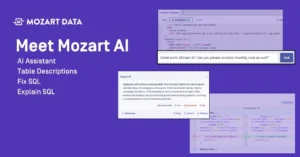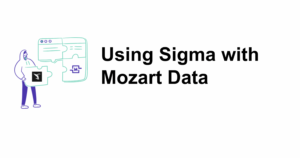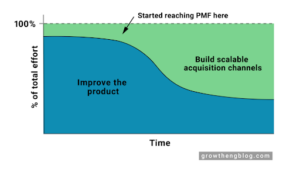TL;DR:
- Data pipeline management is crucial for maintaining data quality.
- Four warning signs that you've outgrown your previous data system include: inability to use analytics tools, data transfer failure, lacking data observability, and manual data pipeline maintenance.
- Mozart Data is a modern data platform that offers automation, observability, and built-in management features to address and overcome these issues.
- Mozart Data offers a complete data pipeline that connects industry-leading data tools in a single platform, with additional data transformation and pipeline observability tooling.
- Mozart Data reduces the time to new insights with data pipeline automation, making sharing data with analytics tools easier.
The job of a data pipeline is to move data from one source to a storage location. Sounds easy, right? In practice, it is never that simple.
Depending on use cases, there can be layers upon layers of data transformation. Once you add transformation, there’s the question of whether you transform before or after loading data into storage (ETL vs. ELT). And then, on top of that, there’s the question of how you monitor and manage the whole data pipeline.
It’s really no surprise that it's a struggle to maintain data quality without a robust data strategy and data pipeline management. Bringing in a new modern data pipeline tool can fix these issues and provide you with observability into your systems, but how do you know you’re ready for a change?
Look for these four warning signs that you’ve outgrown the capacities of a previous data system:
- You can’t use analytics tools
- Your data is not arriving in storage
- You can’t diagnose data failures with observability data
- Manual tasks are consuming too much of your time
Can’t Use Analytics Tools
When you go to build an analytics report for an executive board, and your data visualization tool fails to show a line, you have a serious data problem. Even worse is if an executive outside your team is the first to report the failure of one of your data dashboards.
Because the process of data centralization, transformation, and then routing to BI tools involves a series of steps, there are many potential points of failure.
Perhaps there was an error in sending the latest batch of data, so your tool sent a copy of the previous data instead. Perhaps your BI tool is unable to display anything at all because of a null field. Or maybe a data connection needed to be updated.
While some errors can be fixed individually, embracing data pipeline management tools with automated features can remove whole classes of errors. With modern ETL tools, the transformation layer helps protect your data from quality degradation. It can remove duplicate fields, put in analytics-friendly placeholders for null fields, and standardize data so it works with your analytics tools.
Data Transfer Failure
Data failures can be minor issues that go undetected for weeks or big issues that are immediately obvious. A major cause for full load errors is infrastructure errors and time-outs.
The demands of loading bulk data can be alleviated by switching from ETL to ELT, which moves the resource-draining transformations to after data has been centralized. Mozart Data aids the ELT savings further by using a Snowflake warehouse which has unlimited capacity for transformation.
With data failure, observability also becomes key to track down previous versions of data and transforms and see what triggered the error.
Lacking Data Observability
All systems go wrong at some point, but having observability into that system to find out why it went wrong can be as important as fixing the problem.
Data observability means having the ability to answer questions about processes of transforming, transferring, and replicating data. Data pipeline monitoring tools can help with forensic investigations by supplying a data lineage, which is a record of all data changes.
Oftentimes, teams that use open-source data pipeline solutions are so involved with maintenance tasks that setting up the monitoring tools ends up being overlooked, making finding root causes of data errors much more difficult, if not impossible.
Data Pipeline Maintenance
Managing your data manually can add hours to your process. Having to export CSV files, join data, or actively choose which fields from a database to include can restrict data analysts’ ability to conduct actual analysis.
Many teams find that if they choose an open-source solution, the time spent implementing pipeline tools far exceeds what they initially expected. It often results in taking up time of data engineers, taking them away from actual analysis tasks. Data orchestration tools like Mozart Data can automate data processes and free up labor hours.
Mozart Data – a Reliable Modern Data Pipeline Solution
As a modern data platform built with automation, observability, and built-in management features, the Mozart Data pipeline addresses and overcomes the major issues you may have with your current data pipeline.
Mozart offers a complete data pipeline that connects industry-leading data tools Fivetran, Portable, and Snowflake in a single platform, with additional data transformation and pipeline observability tooling. To support success, Mozart actively works with you to adjust data pipeline architecture to meet your needs while providing automated updates, managed configurations, and transformations (including some prebuilt transformations).
The pipeline isn’t complete until the data is made accessible. In addition to preventing errors by design, Mozart makes it easier to share data with analytics tools. Using reverse ETL, it moves data from a data warehouse to locations like Excel documents, Google Sheets, or BI tools where users with any level of technical expertise can access and analyze data.
Mozart supports data observability through data lineages, run histories, version histories, snapshots, and more. Mozart infers data lineage automatically, removing the need to configure a system to track it. Mozart supports further access to data by offering support for third-party data, code, and task management tools, like GitHub.
Most importantly, Mozart reduces the time to new insights with data pipeline automation. Setting up Mozart takes minutes. Mozart offers automation for moving and transforming data. Data extraction can be prescheduled. Transforms in SQL can be pre-configured and scheduled to run only when data in the source tables has been refreshed, so you’re never working with outdated data.
Learn more about data pipelines, data strategies, and best practices by visiting our data pipeline tools page. Or, schedule a call with a member of our team.



